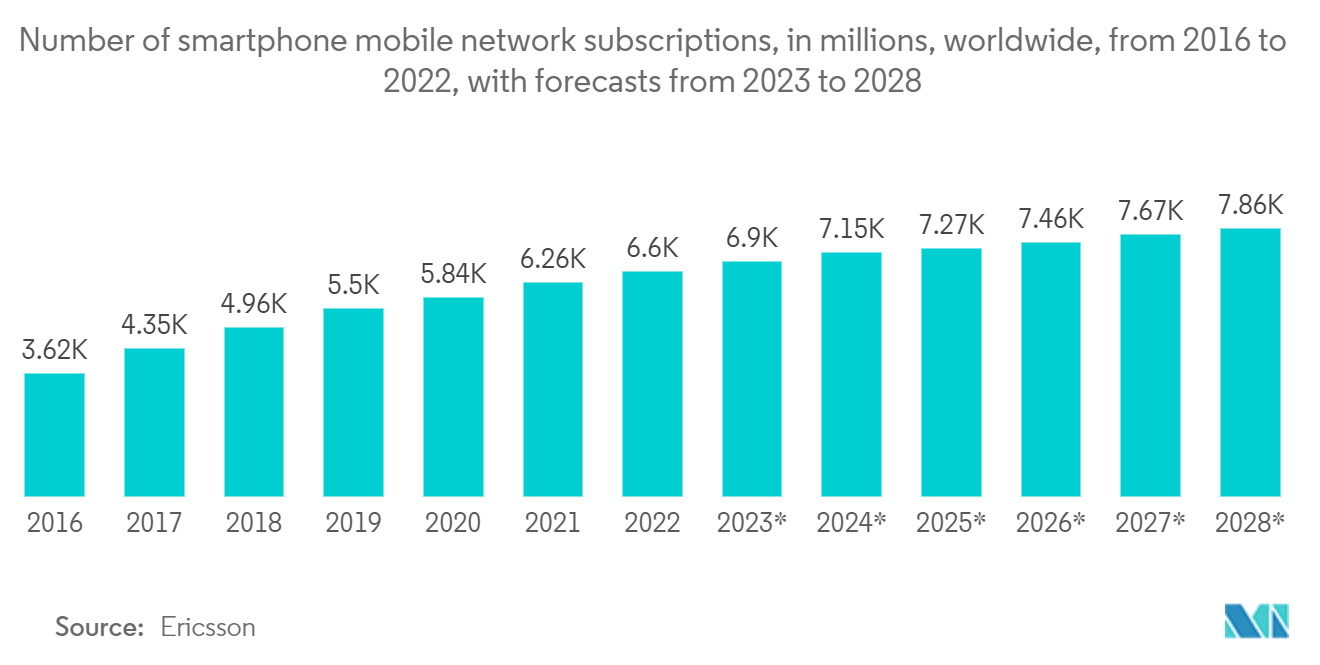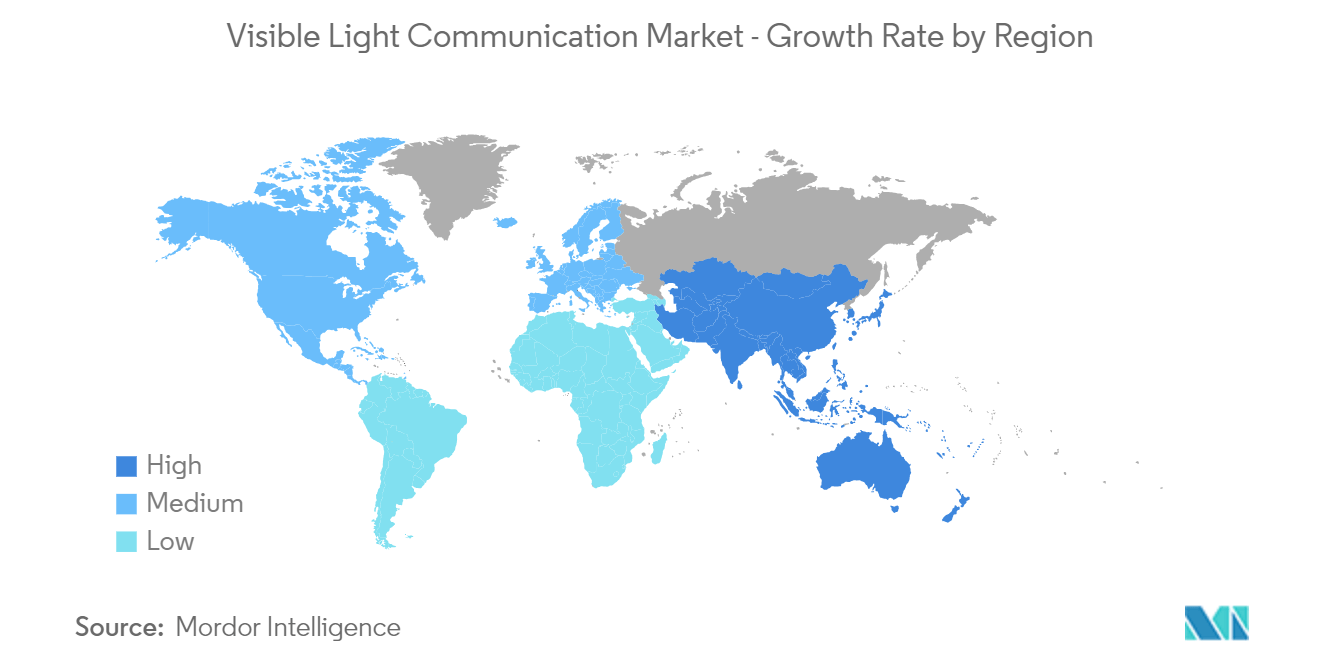Market Trends of Visible Light Communication Industry
The Consumer Electronics Segment is Anticipated to Witness a Significant Market Growth Rate
- Visible light communication technology can be used on smartphones for data transmission between devices using available screens and smartphone cameras. VLC can establish wireless connections between mobile devices like smartphones, laptops, and tablets. These connections can transfer data, including photos, music, and video. The receiver captures data from the screen of a transmitting smartphone and utilizes algorithms like the Speeded Up Robust Features (SURF) algorithm to detect and extract information. Additionally, VLC-enabled smartphones can be used for indoor navigation systems for visually impaired people and for initializing Internet of Things (IoT) devices through BlinkComm, which uses the smartphone screen as a modulated light source for VLC.
- According to Ericsson, the global number of smartphone mobile network subscriptions reached over 6.6 billion in 2022 and is expected to hit 7.8 billion by 2028. The countries with the most smartphone mobile network subscriptions are China, India, and the United States. Such a huge smartphone rise would create lucrative opportunities for the studied market.
- The demand for high-speed data transmission is increasing in various applications, including streaming video, gaming, etc. VLC can provide high-speed data transmission without wires or cables, making it a promising alternative to traditional wired and wireless communication technologies. For instance, the European Union is investing in 5G, and the bloc is expected to have 5G networks by 2025. The European Commission has set aside Euro 7 billion for 5G research and development, which will help to accelerate the growth of new 5G applications.
- Further, according to the Ericsson Mobility Report released in November 2022, 5G mobile subscriptions were anticipated to reach approximately 5 billion by the end of 2028. Additionally, 5G population coverage is anticipated to reach 85%, while 5G networks will likely carry around 70% of mobile traffic by 2028. Such events are also likely to drive the demand for consumer electronics, thereby boosting the growth of the studied market.
- In September 2022, researchers at the Nanjing University of Posts and Telecommunications in China demonstrated a new visible light communication system that utilizes a single optical path to develop a multi-channel communication link over the air. This approach could be employed as a backup communication link or for connecting IoT devices. It is based on devices called multiple quantum well III-nitride diodes that can emit and detect light at the same time. The communication mode could eventually be used to develop a photonic CPU. Such innovations are anticipated to boost the adoption of VLC in the consumer electronics segment.
- Additionally, the popularity of smart home devices is increasing as consumers look for ways to make their homes more comfortable, convenient, and secure. VLC can control smart home devices, making it a key technology for the market.

North America to Account for the Largest Market Share
- Visible light communication has emerged as a promising vehicle-to-vehicle (V2V) communication technology and is being explored for autonomous vehicles. Vehicular VLC (V-VLC) utilizes vehicle headlights and taillights as wireless transmitters, and as LED technology has become more prevalent in vehicles and infrastructure, opportunities for V-VLC have increased. V-VLC has demonstrated a range of up to 100 meters for headlights and 30 meters for taillights, making it suitable for short-range communication needs.
- The National Highway Traffic Safety Administration (NHTSA) defines "autonomous" or "self-driving" vehicles as those that operate without direct driver input to control acceleration, steering, and braking and are developed so that the driver is not anticipated to monitor the roadway while using in self-driving mode constantly. According to the Insurance Institute for Highway Safety, 3.5 million self-driving vehicles will be on American roads by 2025 and approximately 4.5 million by 2030. Such huge Autonomous vehicles would drive the studied market.
- As traffic lights employ LED lighting, it is an emerging opportunity in citywide traffic management systems, like pedestrian signals and traffic signals using VLC. For instance, streetlights communicating with a pedestrian's VLC-equipped smartphone can regulate vehicle traffic, allowing pedestrians to cross a street. VLC technology in traffic systems facilitates drivers to use smart devices or car headlights to connect and generate information from traffic lighting systems. This information can also be transmitted to other cars using taillights. Information, such as traffic updates, the shortest estimated arrival time to a specific location (considering traffic congestion), or even internet access, can be communicated through this technology.
- The adoption of LED in the United States boosted the market growth. According to the U.S. Department of Energy, LED lights are expected to gain popularity in the United States between 2020 and 2035, particularly in outdoor applications. LED lights should be implemented in 93 percent of outdoor lighting by 2025, making them the most prevalent light source across all industries.
- Increasing indoor location-based services embedded with light fixtures in hotels and retail shops in the North American region is also projected to be one of the factors driving revenue growth in the region. Several companies, such as G.E. Lightings and ByteLight Inc., are deploying VLC installations in supermarkets, which, in turn, is aiding retailers in tying customers' shopping history by tracking their location details.
- Further, the applications of VLC in smart homes include smart lighting systems, home automation & control, energy monitoring, and even battery-free duplex communication for mobile & IoT devices. According to Consumer Technology Association, particularly in the USA, 22 million homes already employ IoT or smart technology to make life easier. By 2023, the smart home market is estimated to produce USD 23.5 billion in revenue. The increasing adoption of smart homes in the region is anticipated to significantly boost the growth of the studied market.


